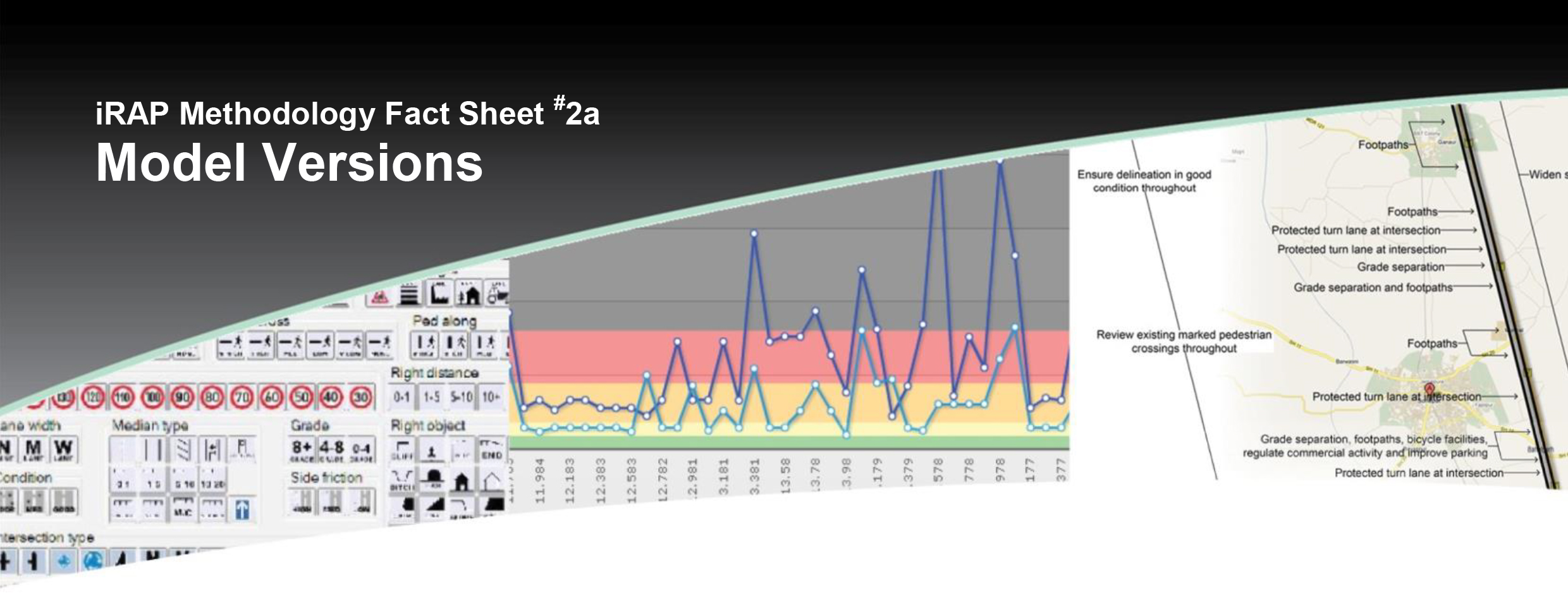Fact Sheet 2a: Model Versions

This factsheet is part of a series that describes the iRAP methodology. It provides an overview of the Star Rating and Safer Roads Investment Plan model version management.
Related documents
This factsheet should be read in conjunction with:
- Other factsheets in the iRAP Methodology Fact Sheet
- iRAP Road Attribute Risk Factor Fact Sheets.
- Road Safety Toolkit.
Introduction
The iRAP Star Rating and Safer Roads Investment Plan model (the ‘model’) used today is the result of more than a decade of development work, which began with EuroRAP (http://www.eurorap.org) in 1999. The iRAP Methodology Fact Sheet #2: Development History (https://irap.org/about-irap-3/methodology) provides more information.
Managing model development
The iRAP methodology, technical integrity of its application and its development is based on the latest road engineering safety knowledge. This is overseen by experts in the Global Technical Committee (GTC). More information about the GTC is available at: https://irap.org/about-irap/global-technical-committee.
Why the model changes
Changes to the model occur for three reasons:
1. To take account of the latest research and experience in applying the model. For example, new road attributes were added to version 3, including street lighting and skid resistance, because new research on road attribute risk factors became available.
2. To refine the model. For example, in version 2.2 the ability to record the paved shoulder widths on both sides of the road was added.
3. To correct errors and make enhancements. For example, in version 3.02.00 of the model, names of Vehicle Parking categories were changed so that they were easier to understand.
Model naming convention
The model versions names correspond to the three reasons that models can change. They are as follows:
* vX.00.0 (for example v3.00.00, sometimes referred to as version 3 or simply v3).
* XX.0 (for example v3.01.00, sometimes referred to as version 3.1 or simply v3.1).
* 00.X (for example, v3.01.01, sometimes referred to as version 3.1 or simply v3.1).
Frequency of major changes to the model
While there is benefit in ensuring that the model reflects the latest research and experience, we are also conscious that frequent changes to the model would cause significant uncertainty for programs assessing roads and tracking performance over time.
For this reason, major changes to the model do not frequently occur.
Since the first edition (version 1) was first used in Europe in 2004, there has been two major changes. Version 2 was put into use following the iRAP pilot projects in Chile, Malaysia, Peru and South Africa in 2006, and version 3, the most advanced version, was put into use in 2013.
There are currently no plans for the release of a version 4 model.
Comparing results from different models
* Results produced using models with different vX.00.0 names have only limited compatibility. We recommend that these results are not presented for comparison. For example, results produced using v2 and v3 should not be compared.
* Results produced using models with different v0.XX.0 names are broadly compatible. For example, results producing v3.01.00 and v3.02.00 can generally be compared, though some differences might be apparent in detail.
* Results produced using models with different v0.00.X names are compatible. For example, results producing v3.01.01 and v3.01.02 can be compared.
Selecting a model
Responsibility for selecting a model rests with the program manager. This may be delegated to project managers.
We strongly encourage programs to use the latest model in new assessments. That way, assessments will benefit from the latest research and development.
However, we recognize that there are many reasons why it might be preferable to continue using an older model. For example:
* It might be necessary to compare Star Rating results for a network of roads over time (performance tracking).
* Road designs have been developed using a specific version of the model and subsequent Star Rating assessments of the designs need to be made on a consistent basis.
* The Star Ratings of a network of roads are being benchmarked against a different network that was assessed in the past.
Converting between models
iRAP has tools that can be used to convert data between different model versions. For example, data in v2 can be converted to v3. However, additional road coding attributes might need to be collected.
In v2 for example, the presence of street lights is not recorded for but it is recorded for v3. To avoid this data collection, it is possible to make assumptions to be made about these road attributes, though this will obviously have an effect on the accuracy of the data.
Which software to use
Currently, version 2 of the model is hosted at: http://www.iraptools.net. Version 3 of the model is hosted at http://vida.irap.org. Version 1 of the model is only available in Microsoft Excel format. In the future, all model versions will be hosted at http://vida.irap.org.
Presenting and publishing results
In the interests of transparency and accountability, results in presentations, reports, papers and articles should be accompanied by a record of the model version name(s).
More information and help
If you would assistance in developing a model version strategy for your program, or have more questions, contact:
James Bradford
Global Operations Manager iRAP
E: james.bradford@irap.org
16 April 2014, © International Road Assessment Programme (iRAP) 2014.

















